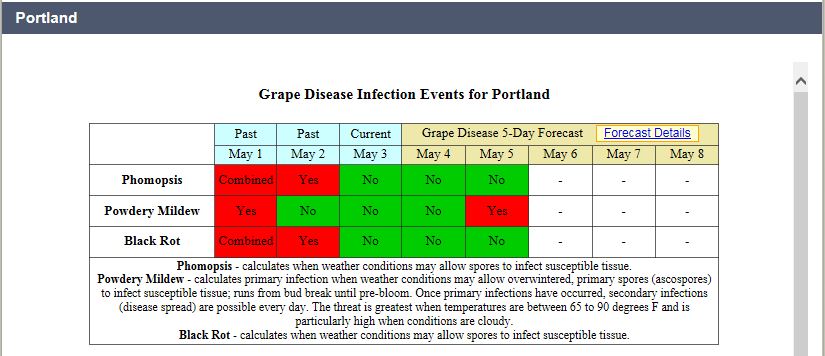A question came up at our Coffee Pot meeting yesterday, May 3, about whether a 3- to 5-inch shoot spray for Phomopsis was necessary, or if they could wait until the 10- to 12-inch shoot growth stage. One of the reasons this came up is that we are quite a bit ahead of last year and dodging the frequent rain this spring has made field work difficult. Also, the variety of tasks needed to be done at this time of year makes setting priorities, well, a priority.
When determining the priority of a 3- to 5-inch Phomopsis spray look at:
Susceptibility of the variety – The work done by Wayne Wilcox that showed a significant reduction in yield due to the loss of the shoulder of the cluster from Phomopsis infections was done in a Niagara vineyard. While Concord is also highly susceptible to Phomopsis infection, field observations over the years indicate that Niagara is just as susceptible or slightly more so. For a more complete list of varietal susceptibility to Phomopsis infections you can go to the NEWA website at http://newa.nrcc.cornell.edu/grapes/phomopsis_var_table.html
Availability of inoculum – Phomopsis overwinters in cane and rachis lesions so training system can be very important in limiting the level of overwintering inoculum. Minimally pruned vines, vines which are machine pruned and receive no hand follow up, and hand pruned vines that look like they were machine pruned, all have an increased chance of leaving up multiple infected canes and rachises that will produce inoculum in the spring as compared to a traditional hand pruned top wire cordon or training systems used with varieties that have a more upright growth habit. Since the inoculum is rain splashed onto new tissue, the upright growth habit of some varieties results in susceptible tissue growing above the infection zone rather in it. NYS IPM Factsheet is available at: https://ecommons.cornell.edu/bitstream/handle/1813/43104/grape-phomopsis-FS-NYSIPM.pdf?sequence=1&isAllowed=y
Severity of infection periods – The Network for Environment and Weather Applications (NEWA) http://newa.cornell.edu provides a Phomopsis infection event model that, when combined with the National Weather Service five day forecast, can provide information on what infection periods have occurred as well as the likelihood of weather conditions favoring Phomopsis infections will occur in the next 48 hours. As seen in the table below “Grape Disease Infection Events for Portland” from the NEWA site, the model tell us that we had conditions which met the requirements for a Phomopsis infection period to occur on both May 1 and May 2.

This table tells us if an infection period occurred, but not the severity of the infection period. For that information you will need to scroll down further on the page and click the button Show grape infection events log which can be found on the left side of the screen just under the Disease Management table. Looking at the grape infection events log below for CLEREL in Portland, NY, it looks like there have been 4 infection periods recorded so far this spring. However, when the date of bud break is factored in, there has only been one infection event that has occurred when susceptible tissue was available. That one infection event lasted for 21 hours at an average temperature of 54.6 F which would be considered a significant infection event.

Putting it all together. In answer to the question at the Coffee Pot meeting, we determined that the vineyards in question were either Niagara or Concord and the Concord had received different pruning tactics, machine pruned which has left old canes and rachises in the canopy, hand pruning with enough canes left up to be considered similar to machine pruned and more traditional hand pruned. All vineyards had a history of Phomopsis. The recommendation was to NOT wait until the 10- to 12-inch shoot growth stage to get started with a Phomopsis spray program. All the materials we currently have are protective in nature, so they need to be applied prior to an infection event to be effective. Treatment of vineyards can be prioritized as follows, 1) Niagara vineyards, 2) vineyards that have been machine pruned with little or no hand follow up to remove old canes, 3) hand pruned vineyards that were left heavily wooded and lastly any vineyards that were more like traditional hand pruning.
If you have questions about early season disease management programs, or implementing any IPM strategy in your vineyard operation, please get in touch with either Tim Weigle thw4@cornell.edu or Andy Muza at ajm4@psu.edu

